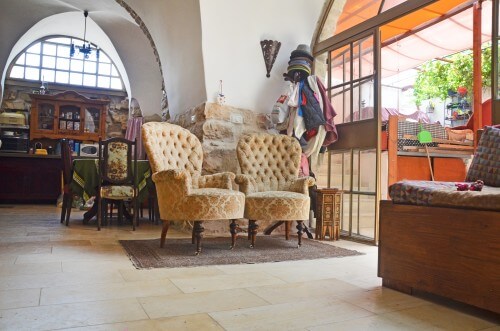An ancient mikveh found during renovations in a living room in Ein Kerem strengthens the belief that there was a Jewish settlement there during the Second Temple period. The owners of the apartment received a certificate of appreciation for discovering the mikvah and reporting it to the Antiquities Authority, which added information about the destruction period

During renovations carried out in a private house in the picturesque Ein Kerem neighborhood in Jerusalem, an ancient 2000-year-old purification mikve was discovered under the living room of the house. The people of the Antiquities Authority were surprised to discover that under a stylish carpet, in the center of the living room of a hospitable family, there is a pair of wooden doors hiding an ancient mikveh.
This morning (Wednesday) the owners of the place were awarded a certificate of appreciation by the Antiquities Authority for showing good citizenship by reporting the discovery of the mikvah, thus contributing to the study of the land.
The mikvah is complete, large (3.5 m length, 2.4 m width, 1.8 m depth) carved in rock and plastered and strictly according to the laws of purity that appear in the Halacha. A staircase leads to the bottom of the baptismal font. Inside the mikvah were found pottery from the days of the Second Temple (1st century AD) and signs of burning, (which may be evidence of the destruction of 70-66 AD. Fragments of stone vessels that were customary in the days of the Second Temple were also found, since stone does not accept Impurity and remains pure.
According to Amit Ram, Jerusalem district archaeologist: "Such cases, of finding antiquities under a private house, can only happen in the Land of Israel, and in Jerusalem in particular. Beyond the excitement and the unusual story of the discovery of the mikvah, its discovery has archaeological importance: Ein Kerem is considered a holy place for Christianity due to its identification with the "City of Judah" - the place where, according to the events of the New Testament, John the Baptist was born, and where Elisheva - John's mother, while pregnant , Mary, mother of Jesus.
Despite these identifications, the archaeological remains in Ein Kerem and its surroundings related to the period in which these events took place (the Second Temple period) are not numerous and fragmented. The finding of the mikveh strengthens the argument that in the area of today's Ein Kerem, there was a Jewish settlement in the days of the Second Temple.
The owners of the place say: "At first, we didn't know for sure what the importance of the find that was discovered in the area of our house was and we hesitated to contact the Antiquities Authority, because of the consequences that we believed would be involved. At the same time, we were accompanied by a strong feeling that apparently a find of historical value lies under the floor of our house, and the civic and public commitment tipped the scales. We felt that this finding deserves to be visible and properly documented. On our own initiative, we contacted the Antiquities Authority in order to complete the excavation and the work of documentation. The representatives of the authority arrived, and together we cleaned the mikvah. To our delight - and it must also be said to our surprise, we found worthy partners in this fascinating journey. The members of the Antiquities Authority demonstrated great professionalism, matter-of-factness and pleasantness. All their concern was for preserving the findings and investigating them."


More of the topic in Hayadan:

3 תגובות
Is it possible to visit Beit Mishmacha and see the mikvah?
In any case, at which address is it?
Yoske:
Perhaps a question of ignorance, but as a Zionist with a belief in the historical background of our people, that the land was the property of our ancestors in the past.
Is it possible to demand a possession document / or ownership of parts of land where there are signs of Jewish Jewish settlement in the past
Based on archeological evidence alone, suppose that Palestinian refugees in Lebanon hold keys to their homes in the past, before the "occupation" and their desire to exercise the right of return.
Did they come out without any damage?
What exactly is the law in such cases?
Can the state do what it wants with the house, or does their property right increase?
Does the place still belong to them?
Can they charge for visitor entry?
I would appreciate answers, even partial ones.
The Antiquities Authority should publish its positions. If they are really as nice as the story implies, maybe more people will report to the authorities.